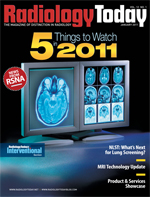January 2011

Radiation Dose Reduction
By Jim Knaub
Radiology Today
Vol. 12 No. 1 P. 6
After catching numerous pitches about scanner “A” reducing dose up to 65%, scanner “B” dropping it nearly 75%, and yet another one cutting it 80% or more, I couldn’t help wondering: compared with what? A four-slice scanner set at 100 Kv? A 16-slice scanner set at 120 Kv? The Master Chief with his Covenant death ray set to kill?
The so-called PROTECTION I study published in JAMA in early 2009 sought to shed some light on the complex dose equation with respect to coronary CT angiography. In a multisite trial of more than 1,500 patients, PROTECTION I reported a mean dose of 12 mSv for cardiac CT exams. Now here’s the complicated part: The range was from roughly 2.1 mSv up to 21 mSv—10 times more.
One researcher in the study postulated that equipment and techniques should be able to reduce the dose to approximately 5 mSv. Patient size, tube settings, and different scanner makes and models are among the numerous variables that contribute to that dose range—and scanner equipment is evolving. Most of the exams in the PROTECTION I study were done in 2007 on 64-slice scanners. Certainly many of those scanners remain in use, but CT makers now offer 128-, 256-, and 320-slice systems—and that’s just for one exam in one modality.
None of this is simple, and the many variables that affect dose are somewhat hidden inside the “reasonably achievable” phrase within the “as low as reasonably achievable” (ALARA) standard. ALARA is an important concept, but who gets to define the “reasonably” in reasonably achievable? A multidisciplinary blue ribbon medical panel, facility management, patients, or trial attorneys?
It’s not as simple as, say, some quantifiable level of carbon dioxide emission in auto exhaust, but it’s certainly possible to more consistently use the lowest dose to obtain a diagnostic quality image. That said, the events of the past two years that have resulted in pressure on radiologists, imaging directors, and technologists to reduce radiation exposure from medical exams serve a valuable purpose. Everyone in imaging should feel the pressure to do the best possible job for imaging patients.
By the way, we’ve changed the title of our popular PACS Platform department; it’s now Imaging Informatics. We did it because the field has expanded beyond just capturing, sharing, and storing images. This month’s discussion with Paul M. Chang on page 8 sums up the change quite well.
Enjoy the issue.
jknaub@gvpub.com

